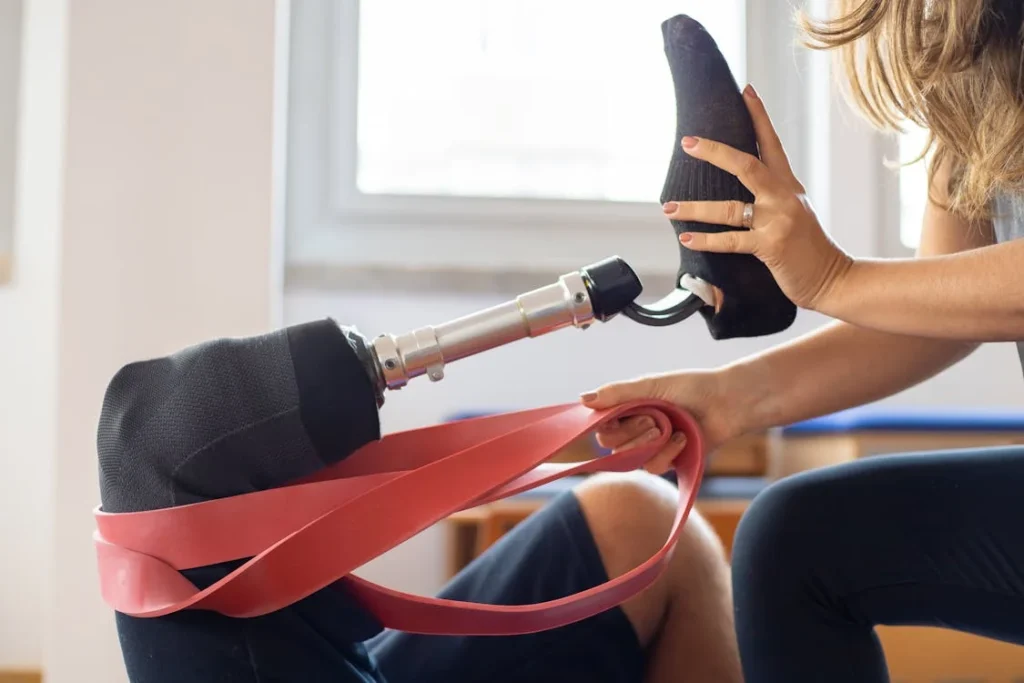If you’ve ever worn a prosthetic limb or known someone who does, you’ll know how important comfort and stability are. But most people don’t realise that a huge part of that stability comes not from the limb itself, but from how it connects to the body. That connection happens through what we call the suspension system and the custom socket. These two elements—though often overlooked—can make all the difference in how stable, comfortable, and usable a prosthetic feels in everyday life.
In simple terms, a prosthetic suspension system is how the artificial limb stays attached to the residual limb. The socket is the part that wraps around the user’s residual limb and forms the main point of contact. Together, these two have to work in perfect harmony. If one fails, the whole prosthetic experience can become difficult, even painful. But when they work well together, the prosthesis almost becomes a part of the user’s body.
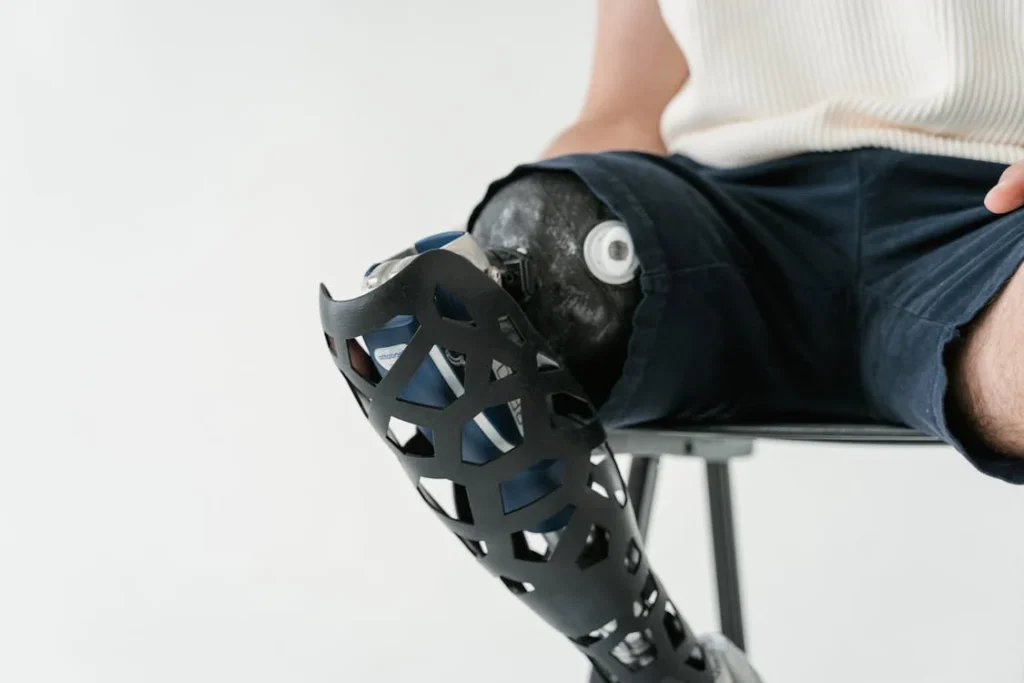
Understanding Suspension Systems in Prosthetics
Suspension systems are the silent heroes of prosthetic limbs. While most people focus on the shape or material of the artificial limb itself, the suspension system is what holds everything together—literally.
Without a proper suspension system, even the most advanced prosthetic would feel loose, unstable, or even painful. This is why suspension is not just a component; it’s a foundation.
Let’s break it down in a simple way.
What Is a Suspension System?
A suspension system is the method used to keep the prosthetic limb attached to the residual limb. Think of it like a belt that holds up your pants, but far more advanced and integrated.
It’s what prevents the prosthesis from sliding off when you walk or lifting up when you take a step. It makes sure your limb moves with your body, not against it.
Now, this may sound straightforward, but here’s where it gets interesting: not every person’s residual limb is the same. People have different limb lengths, shapes, skin conditions, activity levels, and lifestyles.
So, a one-size-fits-all approach doesn’t work here. That’s why choosing the right suspension system is such a personal and critical process.
At Robobionics, we often say that a good suspension system isn’t just about attachment—it’s about connection. It’s what gives users the feeling that their prosthetic is truly part of them.
Why Suspension Systems Are So Important
When a suspension system is working well, it does a few essential things:
- It keeps the prosthetic limb securely in place.
- It prevents friction and movement that can cause skin irritation.
- It ensures smooth, natural movement while walking or performing daily tasks.
- It boosts user confidence by making the prosthetic feel reliable.
On the flip side, a poor suspension system can lead to discomfort, awkward gait, sores, or even the prosthesis falling off. And for people who rely on their limb every day, that’s not just inconvenient—it’s life-disrupting.
So, how does the suspension system manage to provide both grip and comfort at the same time? That’s where the different types come into play.
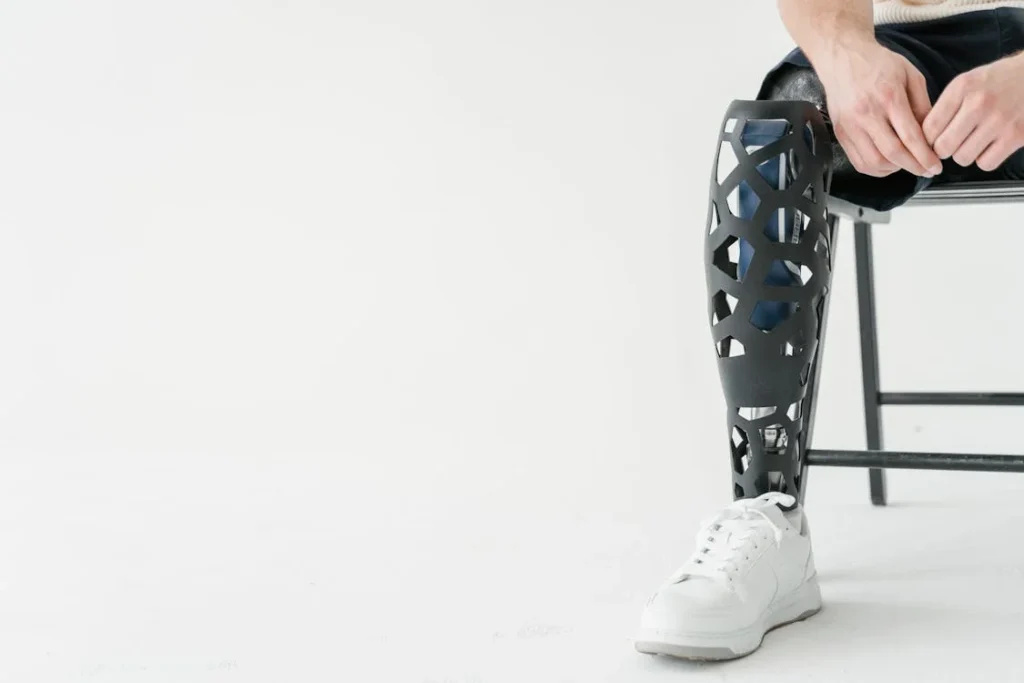
Types of Suspension Systems and How They Work
There are several kinds of suspension systems, each designed for different user needs. Some use suction, others use liners or straps.
Some rely on mechanical parts, while others focus on a snug fit. The best one depends on the person’s residual limb, lifestyle, and preferences.
Suction Suspension
Suction suspension is one of the most commonly used systems today. It works on a vacuum principle. When the user puts on the prosthetic and pushes their limb into the socket, air is pushed out.
A valve prevents air from re-entering, creating a seal that holds the limb in place.
The suction system gives a very close fit, almost like the socket is hugging the limb. It reduces movement inside the socket and gives excellent control. It also tends to feel lighter because the limb isn’t “hanging” from straps.
But suction systems do need a well-shaped residual limb and a bit of strength to don and doff (put on and take off). For users who can handle that, it’s one of the most stable and comfortable systems available.
Pin Lock Systems
Pin lock systems use a gel liner with a pin at the bottom. The user wears the liner over the residual limb, and when the prosthesis is put on, the pin slides into a locking mechanism inside the socket. Think of it like a seatbelt that clicks into place.
This system is secure and easy to use. You hear an audible “click” when it’s locked in, which gives reassurance. It’s also popular among people who want a fast and simple way to attach their limb.
However, some users might feel a slight pulling or “milking” effect at the bottom of the limb, especially during longer walks.
That’s because the pin system relies on a single point of suspension. Still, for many, the ease of use outweighs that issue.
Vacuum-Assisted Suspension
This is an advanced version of suction suspension. It uses a small pump—either mechanical or electric—to create and maintain negative pressure between the limb and the socket.
That pressure keeps the socket snug against the limb throughout the day, even as volume and shape change.
Vacuum systems offer unmatched comfort and limb health. They reduce pistoning (up and down motion) and improve blood circulation in the residual limb.
They’re ideal for active users or those who wear their prosthesis for long hours.
However, they can be more complex to manage and may cost more. They also require regular maintenance.
Strap and Sleeve Suspension
In this traditional method, external straps, belts, or sleeves are used to hold the prosthetic in place. They wrap around the limb or the waist to provide additional grip and support.
While they may not look as sleek as newer systems, straps and sleeves still work well for certain users—especially when other systems aren’t a good fit.
They’re often used as backup or combined with other suspension types.
Anatomical or Passive Suction
This method uses the natural shape of the limb for suspension. A socket is shaped to grip the bony or muscular contours of the residual limb. There’s no valve or pump—just a well-designed fit.
It’s simple, easy to wear, and doesn’t require any external devices. But it only works for certain limb shapes and activity levels.
Choosing the Right Suspension System
Choosing the right system isn’t about picking the most high-tech option. It’s about what fits the user best—literally and emotionally.
Someone who needs to remove the prosthesis frequently might prefer a pin lock. Someone who works in a dusty environment might avoid vacuum systems. And someone with sensitive skin might need a softer liner.
At Robobionics, we always spend time understanding the user’s routine, challenges, and goals before recommending a suspension method. It’s not about the gadget—it’s about the person.

The Role of Custom Sockets in Prosthetic Suspension
A good suspension system can only do its job if the custom socket it connects to is just right. This is where form meets function. The socket is the part of the prosthetic that wraps around the residual limb.
It’s the physical interface between body and machine. No matter how advanced your suspension system is, if the socket doesn’t fit properly, the whole prosthesis becomes uncomfortable, inefficient, and even unsafe.
So, when we talk about maximum stability, we can’t focus on the suspension system alone. The socket and the suspension system must work together like a well-coordinated team.
If they’re not in sync, the user feels every imbalance in each step.
What Is a Custom Socket?
A custom socket is designed to match the exact shape of a person’s residual limb. It’s not picked off a shelf. It’s crafted—often by hand—with input from the user, clinician, and prosthetist.
It takes into account the length, width, muscle tone, scar tissue, skin sensitivity, and even the daily lifestyle of the person who will wear it.
This personalized design allows the socket to evenly distribute weight, reduce pressure points, and ensure a snug but comfortable grip. The result is a prosthesis that feels like an extension of the body, not a foreign object.
At Robobionics, we believe the socket is more than just a shell. It’s the foundation of confidence. When a user trusts that their socket will hold firm, support their movement, and not cause pain, they start to move more freely, stand taller, and live better.
How a Custom Socket Is Made
Creating a custom socket is both science and craftsmanship. The process starts with a detailed evaluation.
We take measurements of the residual limb, assess skin health, muscle condition, and gather input from the user about their activity level and comfort goals.
Then, we take an impression or a digital scan of the limb. From that, we create a mold or digital model. That’s when we begin designing the socket shape. But it’s not just about the physical form—it’s about the feel.
Some users prefer a tighter grip; others need softer padding. Some need relief areas where scars or bone protrusions exist. Some might need special designs to handle sweat or swelling.
We make a test socket first. The user tries it on and walks around. We watch how they move, ask how they feel, and make changes based on real feedback.
Only after this stage do we make the final socket with advanced materials like carbon fiber, thermoplastics, or silicone—depending on what suits the user best.
Socket Fit and Stability
Now here’s the key connection: the socket fit directly affects how well the suspension system works.
If the socket is too loose, even the best suspension system will struggle to keep the limb in place. The prosthesis will move around, causing instability and skin issues. If it’s too tight, it may restrict blood flow or cause pain. In either case, the user’s confidence takes a hit.
That’s why, at Robobionics, we treat the socket and the suspension system as one unit. We don’t just fit the socket and then decide on the suspension.
We design both together, ensuring the liner, locking mechanism, or suction seal fits perfectly with the custom socket shape.
This unified design leads to something we call “intuitive stability.” That means the user doesn’t have to think about every step. They just walk, run, work, and live—naturally. That’s our goal with every prosthesis we create.
How the Two Work Together in Real Life
Let’s paint a picture. Imagine a young man named Arjun. He lost his leg below the knee in an accident. After healing, he’s ready for his first prosthetic limb. He wants to walk to work, play cricket with his friends, and eventually run with his son in the park.
We start by assessing his limb. It’s strong but a little sensitive in places. We decide to go with a gel liner for cushioning and a pin-lock system for simple, secure suspension.
But here’s the catch: we must make sure the socket is shaped perfectly to hold the liner, align the pin, and grip his limb evenly without pinching.
We create a socket with relief zones where his limb is sensitive and use a contour shape to match his calf muscle. The socket has just enough flex to accommodate movement but is stiff enough to provide solid support.
When Arjun takes his first steps, he feels a soft but firm grip. No slipping. No shifting. No noise. Just confidence. He smiles—not because the technology is fancy, but because it works for him.
This is how the suspension system and custom socket combine for maximum stability—not in a lab, but in real life.
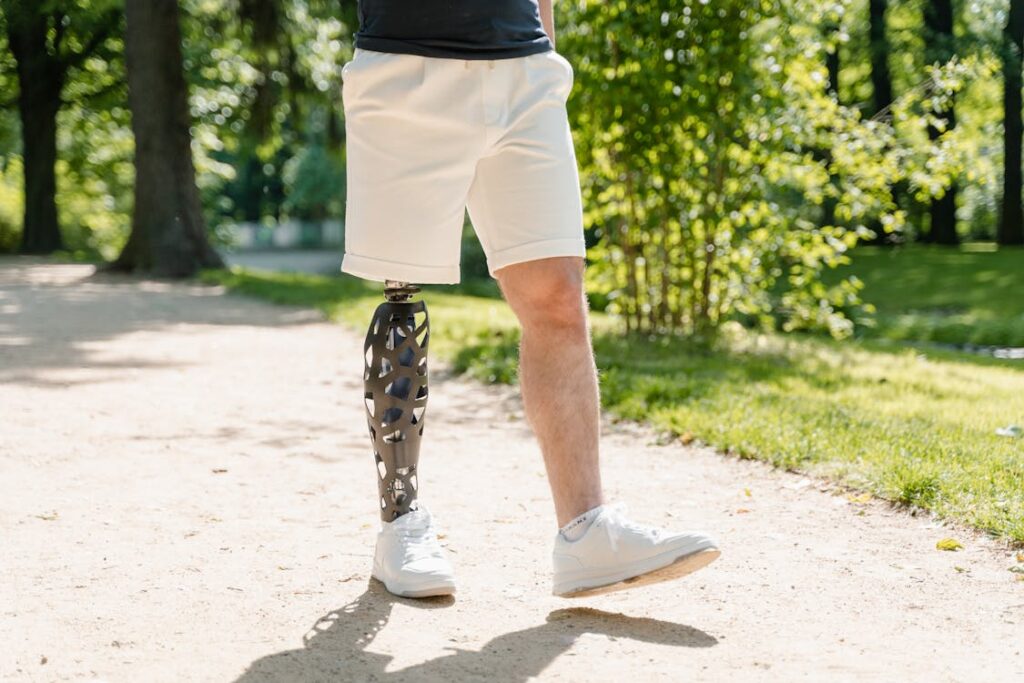
The Science of Movement: Why Stability Matters Every Step of the Way
When we talk about prosthetics, we often focus on appearance or mobility. But underneath all of that, stability is what makes everything work.
It’s not just about whether a person can walk—it’s about how they walk, how they balance, how they feel about their body in motion.
Let’s break down why stability isn’t just a bonus—it’s the core of the prosthetic experience.
What Happens When There’s No Stability?
Imagine walking with a shoe that’s too big. With every step, your foot slips. You lose balance, your gait becomes awkward, and your muscles work overtime just to stay upright.
Now imagine that same experience, but with a prosthetic leg.
Without a stable connection between the limb and the prosthetic, every step becomes a challenge. The user may feel like they’re dragging the limb.
Or worse, they might fear it will fall off. This fear can be exhausting—mentally and physically.
Over time, poor stability leads to bad posture, joint strain, skin damage, and even falls. It also impacts confidence.
A user might avoid walking long distances, running, or participating in social activities simply because they don’t feel secure in their prosthesis.
That’s why, at Robobionics, we place stability at the center of everything we do. Because when the prosthetic feels solid, the user can move forward—literally and emotionally.
How Suspension and Socket Shape the Gait Cycle
Walking may seem simple, but it’s actually a beautifully complex series of movements called the gait cycle. Each leg goes through phases—heel strike, stance, toe-off, and swing.
For a prosthesis to support this cycle naturally, it must remain stable throughout.
The suspension system ensures that the prosthetic limb stays firmly in place through all these phases.
The socket ensures that the contact between the residual limb and the prosthetic is smooth, even, and supportive. Together, they make each transition fluid and controlled.
Let’s look at this in action:
- During heel strike, if the socket shifts or the suspension slips, the user loses immediate confidence. That leads to hesitation in stepping forward.
- During the stance phase, body weight shifts onto the prosthetic. If the socket doesn’t distribute that weight evenly, the pressure causes pain.
- In the toe-off phase, if the suspension isn’t secure, the prosthetic can feel like it’s lagging behind. That throws off rhythm and balance.
- And in the swing phase, the limb needs to move effortlessly. If the socket is too tight or heavy, it restricts movement.
So, a well-designed suspension and socket combo doesn’t just hold the limb—it becomes a part of the user’s walking rhythm.
Stability in Everyday Movements
Stability isn’t only about walking in a straight line. It’s about turning, stepping sideways, climbing stairs, sitting down, getting up, and even running.
Every one of these movements requires the prosthesis to respond predictably and comfortably.
For example, turning quickly requires the socket to hold the residual limb firmly so it doesn’t twist inside.
Climbing stairs needs a secure grip during the moment when most of the body weight is placed on one limb. Sitting down demands controlled bending, which a loose socket would disrupt.
At Robobionics, we often ask our users about their daily routines—not just how far they walk, but how they live. Do they carry heavy bags? Do they cook, squat, or lift children? These questions help us design suspension and socket systems that match movement in real life, not just in the clinic.
Comfort Is a Form of Stability Too
We can’t talk about physical stability without talking about comfort. Because no matter how well a socket holds the limb, if it causes pain or irritation, the user won’t wear it. And when a prosthetic isn’t worn, it’s useless.
Comfort in a prosthesis comes from three main factors:
- Weight distribution – A good socket spreads the user’s weight evenly, avoiding pressure points.
- Skin-friendly materials – Liners and inner socket surfaces must be soft, breathable, and hypoallergenic.
- Sweat and heat management – India’s climate makes this especially important. Ventilation systems or breathable liners can make a huge difference in wearability.
We often use custom liners and advanced materials that adapt to the user’s limb temperature and skin condition. Some even include moisture-wicking properties to reduce sweat buildup inside the socket.
A user who feels comfortable is a user who moves confidently. And confidence is the invisible thread that ties together function, emotion, and independence.
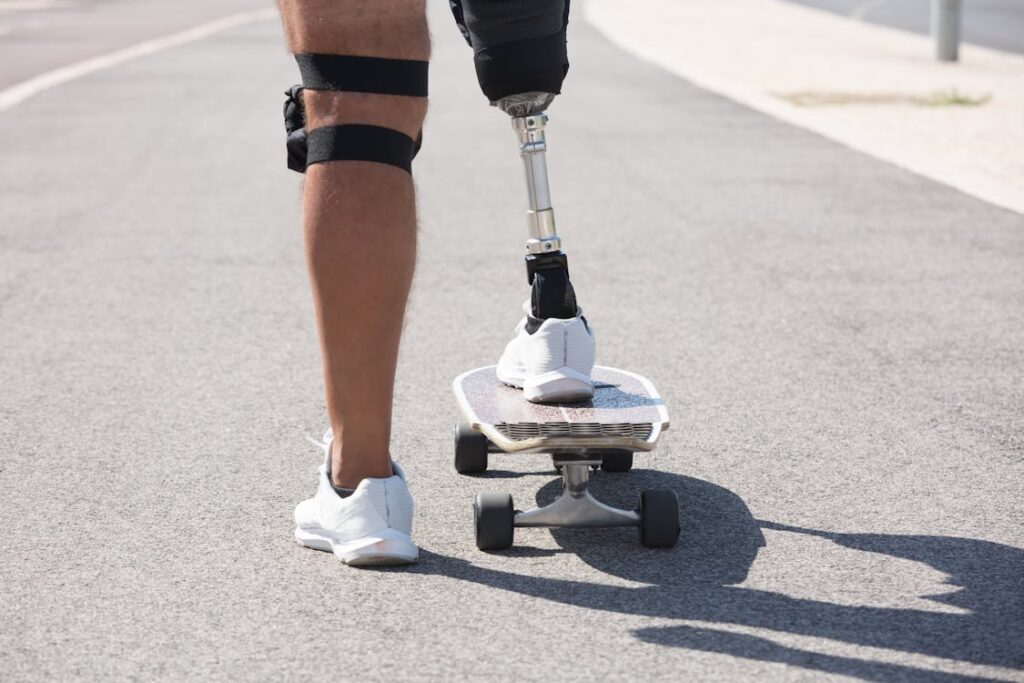
The Emotional Impact of a Stable Prosthesis
We’ve covered the mechanics—how suspension systems and custom sockets work together to keep a prosthetic limb secure.
But there’s another side that often gets overlooked: the emotional experience of the person wearing it. Because the truth is, prosthetics aren’t just about walking—they’re about living. And stability plays a huge role in emotional well-being.
Let’s talk about that.
Confidence Begins with Trust
Think about what happens when someone doesn’t trust their prosthetic limb. Every movement becomes cautious. Every step is calculated.
The mind is constantly worrying: Will it slip? Will it hold? What if I fall? This constant internal dialogue is exhausting.
Now compare that to someone with a stable, secure prosthesis. They step forward without hesitation. They walk into a room without second-guessing themselves.
They don’t need to look down or adjust their limb mid-walk. That’s the power of trust—and it begins with the relationship between the residual limb, the socket, and the suspension system.
At Robobionics, we’ve seen users transform not just physically, but emotionally, when they receive a well-fitted socket with a matching suspension system.
Smiles become more natural. Eye contact is stronger. That’s because when your body feels stable, your mind starts to relax.
Social Confidence and Public Life
In India, where social interactions are deeply woven into daily life, looking and feeling “normal” is important to many prosthetic users.
A secure prosthesis plays a huge part in this. When a limb fits well and stays in place, users are more likely to participate in social events, travel, or even dance at weddings.
They’re less likely to shy away from conversation or avoid going out altogether. A prosthesis that shifts or makes noise can be embarrassing.
One that fits right and moves quietly allows the user to blend in—and more importantly, feel like themselves again.
We often meet users who avoided social functions for years. Once they receive a stable, custom-fitted prosthesis, they return with stories of how they danced at a family function, visited a temple, or took their child to school with confidence. These aren’t just moments—they’re milestones.
Mental Health and Independence
There’s also a deeper, more private impact. When a person doesn’t feel in control of their body, it can lead to stress, anxiety, and even depression.
Many new amputees face emotional struggles, especially in the early months of recovery.
A poorly fitted prosthesis can make things worse. It becomes a constant reminder of what was lost instead of a tool to move forward.
But when the prosthetic feels right—when the socket hugs the limb comfortably and the suspension system holds firm—something shifts. The person starts to reclaim a sense of independence.
They might start doing small chores again. Maybe they take a walk outside. These victories add up, and over time, the emotional burden starts to lift.
This is why we always say that the work we do at Robobionics isn’t just technical—it’s personal. We’re not just shaping sockets and installing suspension systems. We’re restoring balance, both in body and in life.
Adapting to Change: The Body Is Not Static
Here’s something most people don’t realise: the human body changes constantly. Even a residual limb, once healed, will shift in size and shape over time.
It might swell in the morning and shrink by evening. Weight changes, muscle growth, or even weather can affect limb volume. This affects how the socket fits and how the suspension system performs.
So stability isn’t something you achieve once and forget. It’s something that must adapt over time.
Volume Fluctuation and Fit
Even small changes in limb volume can lead to big problems. A socket that fit perfectly last month might feel loose today. That looseness can cause rubbing, which leads to skin irritation or worse.
Or the suspension system might lose its seal, causing the prosthesis to feel unstable.
That’s why many prosthetic users use socks to adjust for volume loss. These socks go over the residual limb before inserting it into the socket, helping to fill the extra space.
But this is only a temporary fix. If volume changes are consistent or large, a new socket may be required.
At Robobionics, we design sockets that allow for micro-adjustments when possible. Some sockets are modular or have adjustable panels that can tighten or loosen depending on need.
This helps maintain stability even when the body changes.
Regular Checkups and Re-Evaluation
To keep the prosthesis stable over time, users need to check in regularly with their prosthetist. This allows us to:
- Reassess socket fit
- Replace worn suspension parts (like liners, sleeves, or pins)
- Monitor skin condition
- Update suspension choices if the user’s lifestyle changes
We encourage every user to treat their prosthesis like a piece of athletic equipment—it needs tuning, care, and attention.
Some users may start with a pin-lock system and later switch to suction or vacuum as their confidence and activity level grow.
Others may want lighter materials or more flexibility after a few years. These updates are part of the natural evolution of living with a prosthetic limb.
At every stage, our focus remains on stability, because it’s the key to everything else—mobility, comfort, confidence, and quality of life.
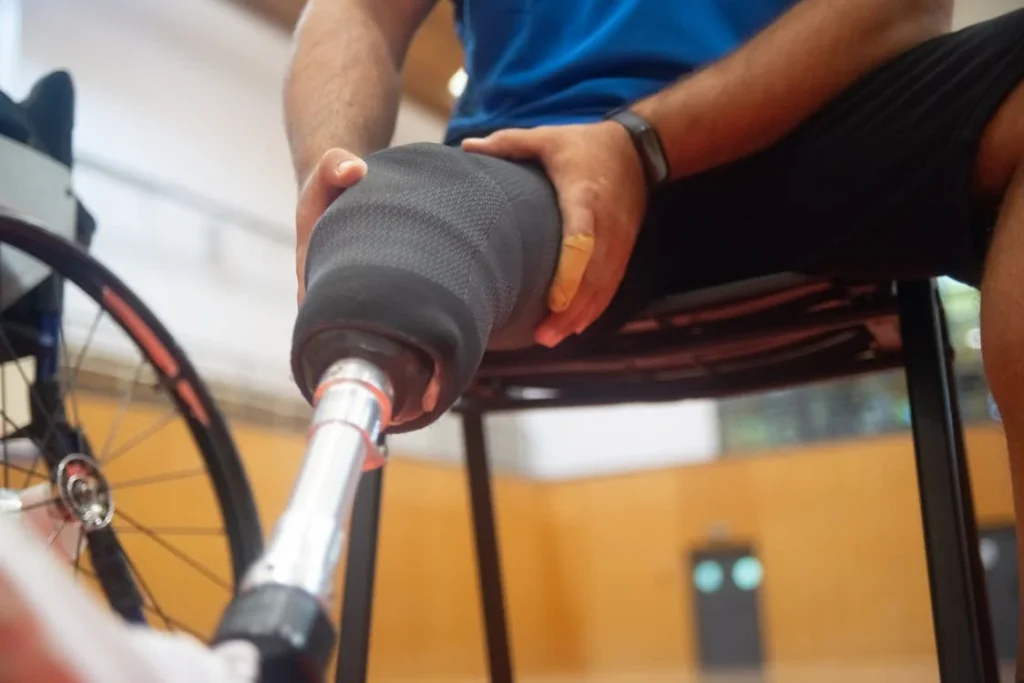
The Material Matters: Building for Strength, Flexibility, and Comfort
Behind every stable prosthetic is not just design, but material science. The types of materials used in both sockets and suspension systems play a critical role in how well they perform.
From the inner liners that touch the skin to the outer shells that bear the load, every component must strike the right balance between strength and comfort.
Materials Used in Suspension Systems
Suspension systems involve multiple elements—liners, sleeves, pins, valves, pumps—all of which must function smoothly and reliably, often under demanding conditions.
Let’s take a closer look at what goes into these parts and why the material makes all the difference.
Gel Liners:
Gel liners are often made from silicone, urethane, or thermoplastic elastomers. These materials offer cushioning and a snug fit around the residual limb.
They adapt to the skin’s shape, provide some level of grip, and protect against pressure and friction.
Silicone liners, for example, are firm and offer a very close, supportive fit. They are often chosen for active users.
Urethane is softer and spreads pressure more evenly, ideal for those with sensitive or bony limbs. Thermoplastic elastomers are more flexible and easier to don.
Sleeves and Covers:
Suspension sleeves are usually made of rubber, neoprene, or silicone blends. These sleeves go over the top of the socket and residual limb, creating an airtight seal in suction or vacuum systems.
The material must be stretchy enough to allow movement and strong enough to withstand repeated wear.
A sleeve that’s too rigid may restrict motion; one that’s too soft may tear or lose grip. We look for high-tensile strength materials that can stretch without losing shape.
Pins and Locking Systems:
These mechanical components are generally made of stainless steel, titanium, or hardened plastic. The choice depends on the user’s weight and activity level. Lightweight materials like titanium offer durability without bulk.
But even here, surface texture and design matter. A pin must slide in easily but lock securely. Any design flaw or wear and tear here can compromise the entire suspension system.
Vacuum Pumps and Valves:
Vacuum systems often include electronic or mechanical pumps, silicone sleeves, and small valves. All these components must be built to precise tolerances.
Poor sealing or weak materials can cause vacuum loss, which leads to instability.
At Robobionics, we test each material not just in the lab, but in real-world conditions—dust, heat, humidity—to make sure they hold up across India’s diverse climates and terrains.
Materials Used in Custom Sockets
Now, let’s turn to the socket—the central piece that holds everything together. It needs to be tough, lightweight, and molded precisely to the user’s limb. And again, the material we use here has a direct impact on stability, comfort, and wearability.
Hard Socket Materials:
These are the materials that form the external structure. Common choices include:
- Carbon Fiber Composites: These are incredibly strong and light. Perfect for high-activity users or those needing long wear without fatigue. Carbon fiber also provides a slim profile, which can make wearing pants or fitted clothing easier.
- Fiberglass Composites: Slightly more flexible than carbon fiber, fiberglass offers good support while allowing a little give. This can be useful in cases where the residual limb changes slightly in shape during the day.
- Thermoplastics: These allow for shaping and re-shaping, which is helpful during initial fitting or for users whose limb size is changing. Though not as durable as composites, they offer an affordable and adaptable option.
Inner Socket Liners and Inserts:
These layers come into direct contact with the skin. They’re made from soft foams, gels, or thermoplastic materials designed to be skin-friendly, breathable, and cushioned.
We often use multi-layer systems. A firmer outer shell holds the structure, while the inner lining provides comfort and reduces friction.
Some advanced liners even include antibacterial properties to reduce the risk of skin issues—especially important in humid regions.
Why Material Choice Matters for Indian Users
India’s geography and climate present unique challenges. High temperatures, humidity, dust, and uneven terrains mean that prosthetics need to be tough and adaptable.
A prosthetic that works well in a climate-controlled western lab might not survive a month of real-world Indian use.
That’s why we at Robobionics often test for:
- Sweat resistance – Materials must not degrade or lose grip due to moisture.
- Dust protection – Especially for mechanical parts like locks and valves.
- UV exposure – Prolonged sun exposure can degrade some rubbers and plastics.
- Weight and breathability – Essential for long hours of wear.
By combining modern material science with local experience, we ensure every suspension and socket system is built for life as it’s really lived—not just for show.
Personalization Through Material Choices
Every user has different priorities. Some want the lightest possible prosthesis. Others want the most durable one.
Some have sensitive skin and need hypoallergenic liners. Others work long hours and need easy-to-clean materials.
We guide our users through these options with hands-on demos and trials. And we always design around their real-world needs—not just textbook specifications.
In the end, material is not just about durability or comfort. It’s about freedom. The freedom to walk without worry. To move without pain. To live without limits.
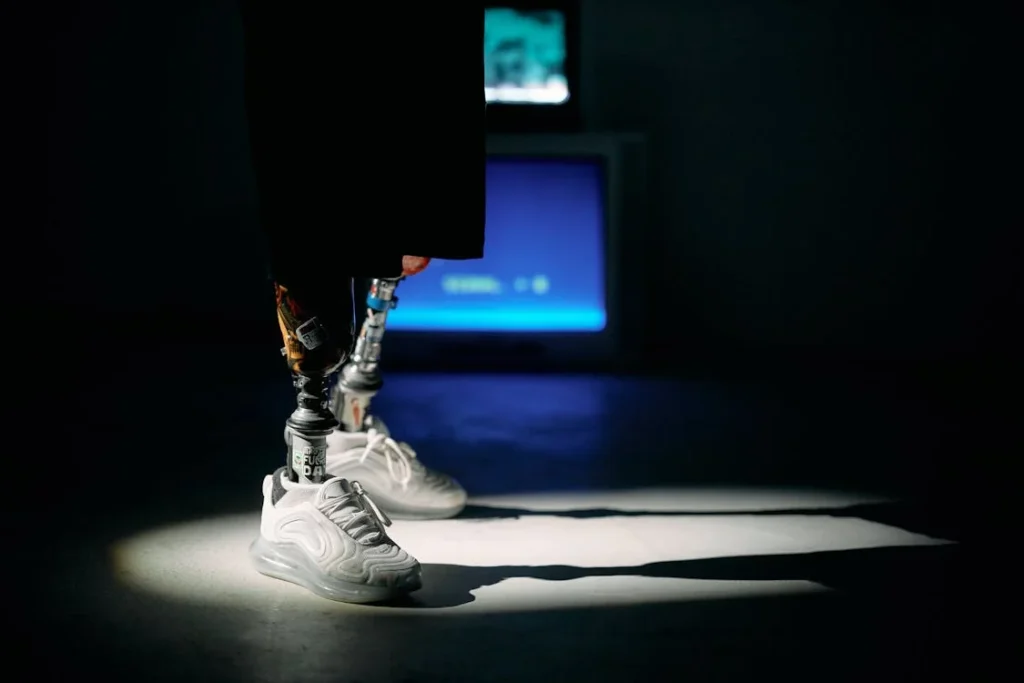
Training the Body: Adapting to Your Suspension and Socket System
Once a user receives their custom socket and suspension system, the journey doesn’t end. In fact, it’s just the beginning. Even the most well-fitted prosthesis won’t feel completely natural on day one.
The body and brain need time to adjust. Muscles must relearn movements. Balance has to be recalibrated. Confidence must be rebuilt.
At Robobionics, we often remind users that adapting to a prosthetic limb is a process, not a moment. But the good news is, with the right training and guidance, this process becomes smoother and more rewarding.
The First Few Days: Getting Used to the Feel
When someone wears a prosthetic limb for the first time, it can feel strange, even uncomfortable. The socket might feel tight.
The suspension might feel too firm or too loose. But this doesn’t mean the fit is wrong—it just means the body isn’t used to the sensation yet.
The muscles around the residual limb haven’t been engaged in the same way since the amputation. Now, they’re being asked to stabilize, support weight, and move in coordination with the prosthetic.
This shift takes effort, and it’s completely normal for users to feel fatigue or soreness in the beginning.
Our team works closely with users during this stage, monitoring every small sign of pressure or friction and making small adjustments. Sometimes it means modifying the socket shape slightly.
Other times, it’s about teaching the user how to put the limb on properly. Even how they stand or shift weight can change how the prosthesis feels.
Balance and Alignment Training
The socket and suspension system might be stable, but that doesn’t guarantee the user will feel balanced right away. Learning to balance on a prosthetic limb takes practice.
Unlike a biological limb, a prosthetic doesn’t provide natural sensory feedback. You don’t “feel” the floor the same way. So, the brain needs time to compensate.
Training starts with basic balance exercises. Standing evenly on both legs. Shifting weight side to side. Taking small steps and paying attention to posture.
Over time, the body learns new balance strategies. The brain begins to use visual and auditory feedback, as well as muscle memory, to keep the user upright and in control.
Proper alignment of the socket and suspension system plays a huge role here. If the socket is even slightly misaligned, it can cause the user to lean, overcompensate, or develop an uneven gait.
That’s why we take such care in positioning every socket with precision. And we always encourage users to come back for follow-ups if something feels off.
Building a Natural Gait
Walking with a prosthetic limb involves retraining the entire body. The hip, knee, and ankle on the prosthetic side must move in sync with the rest of the body.
The opposite leg must adjust to changes in timing and stride length. Even the arms must swing correctly to maintain balance.
A poorly trained gait can lead to long-term problems—back pain, hip strain, or joint degeneration. That’s why we focus not just on walking, but on how a person walks.
We observe them on different surfaces, at different speeds, and with different footwear. We coach them on where to place their weight, how to roll off the toe, how to stand upright.
And we make sure the suspension system isn’t holding them back. If the pin lock causes tugging during swing phase, we might try adjusting the liner or socket.
If suction systems lose grip when the user sweats, we might modify the seal or use a different sleeve material. The goal is always the same—natural movement without conscious effort.
Strengthening Residual Limb and Core Muscles
A prosthetic limb doesn’t just replace a missing part—it asks the body to do more with what’s left. The residual limb must be strong enough to support the socket.
The core muscles must be active to maintain balance. The spine, hips, and shoulders must stay aligned to prevent strain.
That’s why physical therapy is so critical in the early stages. It’s not just about learning to walk—it’s about building a strong, stable foundation.
We often collaborate with rehabilitation experts to create routines that target core strength, limb endurance, and flexibility.
Even something as simple as standing still for a minute without support can be a powerful step forward. These exercises don’t just train muscles—they train confidence.
Every time a user succeeds at a movement they couldn’t do the week before, they begin to believe in their ability again.
Rebuilding Trust in Your Body
For many users, especially those who’ve had traumatic amputations, trusting their body again can be difficult. The memory of pain, the fear of falling, the feeling of being incomplete—these emotions run deep.
The prosthetic socket and suspension system might be perfectly made, but if the mind is filled with fear, movement becomes rigid and unnatural.
This is why we take a holistic approach to prosthetic training. We talk to our users, listen to their fears, and celebrate their small wins.
Whether it’s climbing stairs for the first time, walking unaided across a room, or simply wearing the limb all day without discomfort—every success matters.
Over time, users begin to trust the system. They stop checking if it’s still in place. They stop worrying about what others think. They start focusing on what they can do—not what they’ve lost.
That’s when the magic happens. That’s when the prosthetic stops being a tool and starts becoming a part of who they are.
Conclusion
A stable prosthetic isn’t just about parts—it’s about harmony between the body, the socket, and the suspension system. When these elements come together with precision and care, they empower the user to move confidently, live independently, and reclaim their freedom. At Robobionics, we’ve seen how the right fit can transform lives—not because of high-tech materials alone, but because of thoughtful design, real human understanding, and ongoing support.
From suction systems to pin locks, from soft liners to custom-contoured sockets, every detail matters. And when done right, the result isn’t just a better prosthesis—it’s a better quality of life. Stability isn’t a luxury. It’s the foundation of progress, one step at a time.



